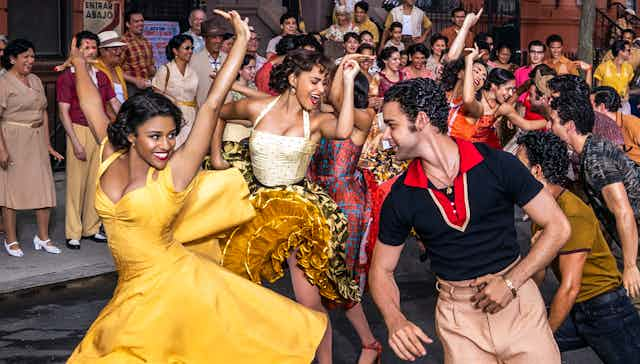The second half of 2021 is proving to be a peak time for movie musical-goers, with the release of critically acclaimed In the Heights, disastrously received Dear Evan Hansen, and Steven Spielberg’s hotly anticipated West Side Story.
These films lead to reflection on one of the stranger sub-genres of film history — the musical stage-to-screen adaptation. To film a stage show (as in the recent professionally shot films of Hamilton and Come from Away), or merely to create bigger stage sets in a studio (there are many examples of this, from Guys and Dolls to The Producers) is not truly to adapt a musical to film.
Instead, adaptors should use the tools unique to film to re-interpret the musical in this different medium.
To help us through the vicissitudes of adaptation, here is an idiosyncratic list of a few DOs and DON’Ts.
DO use real locations creatively
Location shooting is a frequent tool used to enhance the realism of film musicals, but placing the un-realism of song and dance in a real place can backfire and create an uncanny valley. Locations are best used in a super-realistic way.
A successful recent example of this is In the Heights. Director Jon Chu and his production team shot much of the film in Washington Heights in Manhattan, but in a way that the neighbourhood seems a natural place for music-making: very careful lighting, colour-timing, and the occasional unobtrusive effects shot lift the story out of the mundane.

In the number When the Sun Goes Down, lovers Benny and Nina begin singing naturalistically on a fire escape, but then a set on hydraulics, green screen, and “magic hour” lighting come together to enable a gravity-defying dance across the rooftops and walls of the apartment buildings.
See also: Fiddler on the Roof, Jesus Christ Superstar, On the Town
DON’T ghettoise all of the musical numbers to a stark dreamland covered in artistic scaffolding
Counter to the previous guideline about using real locations for musical numbers, some film musicals go too far in the opposite direction.
Two musicals directed by Rob Marshall, Chicago and Nine, puzzlingly use the same solution to try and hedge their bets: the dialogue scenes happen in realistic locations (1920s Chicago and 1960s Rome, respectively) but the musical numbers are relegated to their characters’ internal fantasies, which in both cases means studio-like settings that allow for dancers to be placed in aesthetically pleasing formations.

This strategy gets the filmmakers out of having to bridge the gap between speech time and music time, but the narrative innovations of both shows are smoothed out on screen. That makes for a less interesting filmgoing experience.
The exception that proves the rule here is Cabaret, in which director Bob Fosse removed all of the “book” songs and kept only those performed in the titular cabaret.
Through innovative intercutting and montage the cabaret songs pervade the whole texture of the film, however, resulting in one of the most “musical” of all musicals.
DO fix problems with the dramatic unfolding of the source material
Show Boat was the first stage musical to attempt a truly epic form, covering twenty years of story time and locations all along the Mississippi River.
In 1927, stage mechanics had not caught up with librettist Oscar Hammerstein II and composer Jerome Kern’s ambitions, and the musical, brilliant and groundbreaking as it was, suffered from overlength and a dramatically clumsy second act. The production team fixed these issues in the 1936 film version, as the technologies of montage, dissolve, and cross-cutting that were possible on film allowed for a more effective unfolding of time and place.
The 1965 film version of The Sound of Music similarly fixes problems in the stage version; another epic musical, the stage version feels hemmed-in and stifled.

It is allowed to breathe on film, and the songs are moved around to better reflect what they are actually about (My Favourite Things on stage is sung by the Mother Abbess to cheer up Maria before she leaves the convent!)
See also: Hair, Hairspray, Tick Tick Boom
DON’T adapt a musical to film that didn’t work on stage
Poor Alan Jay Lerner. After the extraordinary success of the film version of My Fair Lady, Lerner attempted film adaptations of three of his other musicals that had been less successful on stage.
Camelot, which had a healthy run on Broadway because of its star actors (Julie Andrews, Richard Burton, and Robert Goulet), its Oliver Smith production designs, and a few excellent songs, rather more than for its unconvincing storyline and structure, was a natural for screen adaptation. But non-singer stars (Richard Harris, Vanessa Redgrave, and Franco Nero), unconvincing plot revisions, and dull direction by Joshua Logan caused it to be an inert behemoth on screen.
Lerner tried again with Paint Your Wagon in 1969, based on a much earlier stage musical that had been only mildly successful with a few hit songs (notably They Call the Wind Maria). But once more, non-singer stars (Lee Marvin, Clint Eastwood, and Jean Seberg), unconvincing plot revisions, and dull direction by (again!) Joshua Logan resulted in yet another inert behemoth.

Third time was not a charm, with On a Clear Day You Can See Forever. This time the stars were singers: Barbra Streisand and Yves Montand. Unfortunately, their talents were hidden by another poorly revised screenplay and, unlike the other two films, this one could have used more of everything, especially music.
Writing this has made me realise that successful stage-to-screen adaptations are quite rare. For every Cabaret there are two Annies and a Man of La Mancha. Spielberg’s new West Side Story will be the first musical he has directed in his long career, and musical-lovers everywhere are optimistic that he will do this classic musical justice.
I merely hope that the only scaffolding to be found is on the fire escapes of 1950s Manhattan!

